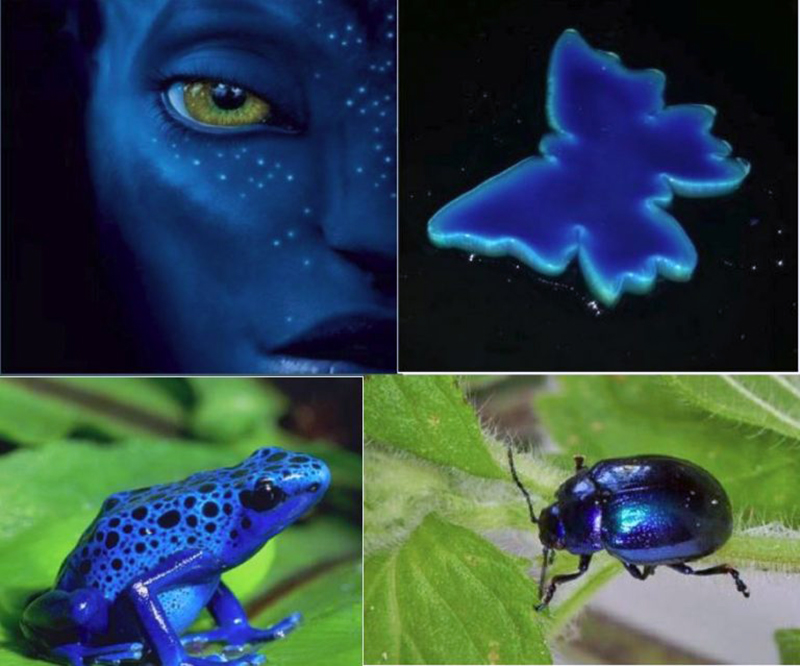Biological materials have complex mechanical properties that are difficult to reproduce using synthetic materials. An international team of researchers, including Dr. Andrey Dobrynin, a professor in The University of Akron’s College of Polymer Science and Polymer Engineering, has produced a biocompatible synthetic material that behaves like biological tissue and changes color when it changes shape — like chameleon skin.
The research is featured in the March 30 edition of Science.
Dobrynin, an Alan N. Gent Ohio Research Scholar, said the research could have powerful implications for the development of a new generation of biomedical devices. In order to produce a medical implant, for instance, the materials must have similar mechanical properties as surrounding biological tissue in order to lessen inflammatory response.

Clockwise, from top left: James Cameron’s “Avatar” character, a thin butterfly cutout of a “PBzMA-bbPDMS-PBzMA” plastomer, a blue mint beetle and a blue poison dart frog.
“Our body can be viewed as an aging car that constantly needs replacement parts,” said the team’s co-author, Dr. Sergei Sheiko, a chemistry professor at the University of North Carolina-Chapel Hill. “Given the steadily aging population, this creates a pressing need for better and more diverse materials for biomedical devices. One key demand is that these materials closely mimic the mechanics of living tissue.”

Dr. Andrey Dobrynin
A number of biological tissues, including the skin, the intestinal wall and the heart muscle, have the characteristic of being soft yet stiffening when they are stretched. The mechanical and optical properties of biological tissue also act in concert to serve living organisms such as chameleons, amphibians, birds and butterflies. The tissues may adjust their colors for camouflage.
“Until now, synergistically integrating mechanical and optical performance has been a big material design challenge because we are essentially trying to mimic the skin of James Cameron’s “Avatar” — soft on touch, stiff upon deformation and colored for appeal or camouflage,” added Sheiko, referring to the 2009 global blockbuster movie.
By controlling polymer architecture, the research team synthesized a physically cross-linked elastomer (polymer with elastic properties) composed of a central block onto which side chains were grafted (like a bottle brush) and with linear terminal blocks at each end. They succeeded in encoding in this synthetic polymer both mechanical and optical properties of natural systems, a feat which had previously never been achieved. Due to its biocompatibility, it does not require additives or a solvent; it remains stable as long as there are biological fluids.
“The design-by-architecture approach reported in our paper will open the door for making materials as soft as brain tissue and as stiff as skin — ideal for direct use as implants for reconstructive surgery and drug delivery,” Sheiko added.
In addition to biomedical implants, this class of materials could have potential applications as mechanochromic sensors, noted Dobrynin, which can signal an unusual level of stress due to fracture, corrosion, or overloading. Think of a prosthetic created with the help of a mechanochromic dye, which is able to detect critical levels of strain and signal the user, through a color change, that it is damaged and in need of repair.
Media contact: Lisa Craig, 330-972-7429 or lmc91@uakron.edu.
